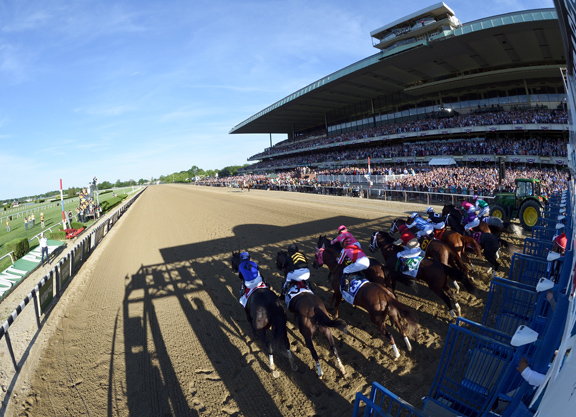By Bill Finley
While still awaiting word from Gov. Andrew Cuomo regarding when it can resume racing, NYRA has submitted a comprehensive plan to the state and the New York Gaming Commission outlining the steps it is taking to maintain a safe environment for those who must be on hand to conduct racing.
The timetable for a resumption of racing at Belmont Park may also hinge on a region-by-region approach to opening the state announced by Cuomo Monday. The Governor's office has divided the state into 10 regions and said each one can start to reopen when they have met seven health-related metrics Three regions have met the criteria and can start to reopen Friday. There will be four phases of the reopening.
No state has been hit harder by COVID-19 than New York. As of May 11, New York has had 26,656 deaths from the coronavirus, almost triple the next closest state.
Belmont Park is part of the Long Island region, which has met five of the seven metrics. Saratoga is part of the Capital region, which has also met five of the requirements.
While it is not clear if Long Island must meet all seven metrics before Belmont can reopen, doing so would no doubt make a resumption of racing there an easier sell. There has been no racing in New York since Mar. 15, when a card was completed at Aqueduct.
“Everyone in Albany is focused on meeting the regional needs first and industry needs second,” said New York Thoroughbred Horsemen's Association President Joe Appelbaum.
Eager to resume racing, albeit without fans, NYRA submitted a 19-page document that details all the steps it will take when given the approval to begin running again. Since Belmont has been open for training throughout the pandemic, many of the provisions are already in place.
“NYRA's plan is the gold standard when it comes to what tracks are doing,” Appelbaum said,
In an outline of the 19-page document provided by NYRA Director of Communications Pat McKenna, it is estimated that only 60 people who are not part of the workforce in place for morning training would be needed to conduct racing. The only employees and staff allowed will be those required to be present under the rules of New York racing.
For daily training operations, the following protocols are already in place:
(*)-The backstretch is closed to all non-essential personnel.
(*)-Those entering the backstretch are subject to temperature checks and standard health questions at entrance gates.
(*)–NYRA is following all New York State Department of Health and the U.S. Centers for Disease Control guidance regarding social distancing. Facial coverings are mandatory for anyone on the property.
(*)-NYRA and the New York Thoroughbred Horsemen's Association have worked together to purchase surgical masks, gloves and face shields and other equipment and have been distributing these supplies to all who need them as necessary.
McKenna said that NYRA “is working aggressively to introduce widely available antibody and diagnostic tests,” which would likely be in place before racing resumes. Similar tests are already being performed at Keeneland and Churchill Downs. Appelbaum was confident that testing will soon be available at the NYRA tracks and that implementing a testing program will hasten the reopening of New York racing.
“Testing is a critical component in the tool kit,” he said. “I don't think any track will be open without an appropriate testing program, so I'm pretty certain we will have one here.”
The NYRA racing community has had the misfortune of having a small coronavirus outbreak on the backstretch, one that led to the death of 63-year-old groom Martin Zapata. For that reason, NYRA management and the horsemen are already well versed in how to deal with the daily problems posed by the coronavirus.
Anyone showing symptoms is promptly tested, either on the backstretch or at a nearby family health center. Belmont Park residents who test positive are placed in isolation in a dedicated quarantine dormitory suitable for these purposes and NYRA personnel conducts a contact tracing program to test those who came in contact with the infected individual. Individuals are released from quarantine only after they have completed at least 14-days and subsequently tested negative for COVID-19.
“Our experience handling outbreaks on the backstretch is critical,” Appelbaum said. “We have been doing testing, tracing and preventative quarantine for eight weeks already. You see the results. We are not unscarred on the backstretch but when you compare us to others situations, like nursing homes or cruise ships, other dorm-like environments, I think our results, knock on wood, have been pretty strong. We are hoping to leverage that so that people understand we can create a safe environment to race under.”
Cuomo has said that he welcomes the return of sports in New York and has encouraged operators to develop business models that cover health concerns and the economic viability of reopening. NYRA has done just that. The only thing missing is the government's blessing to begin racing.
Not a subscriber? Click here to sign up for the daily PDF or alerts.






